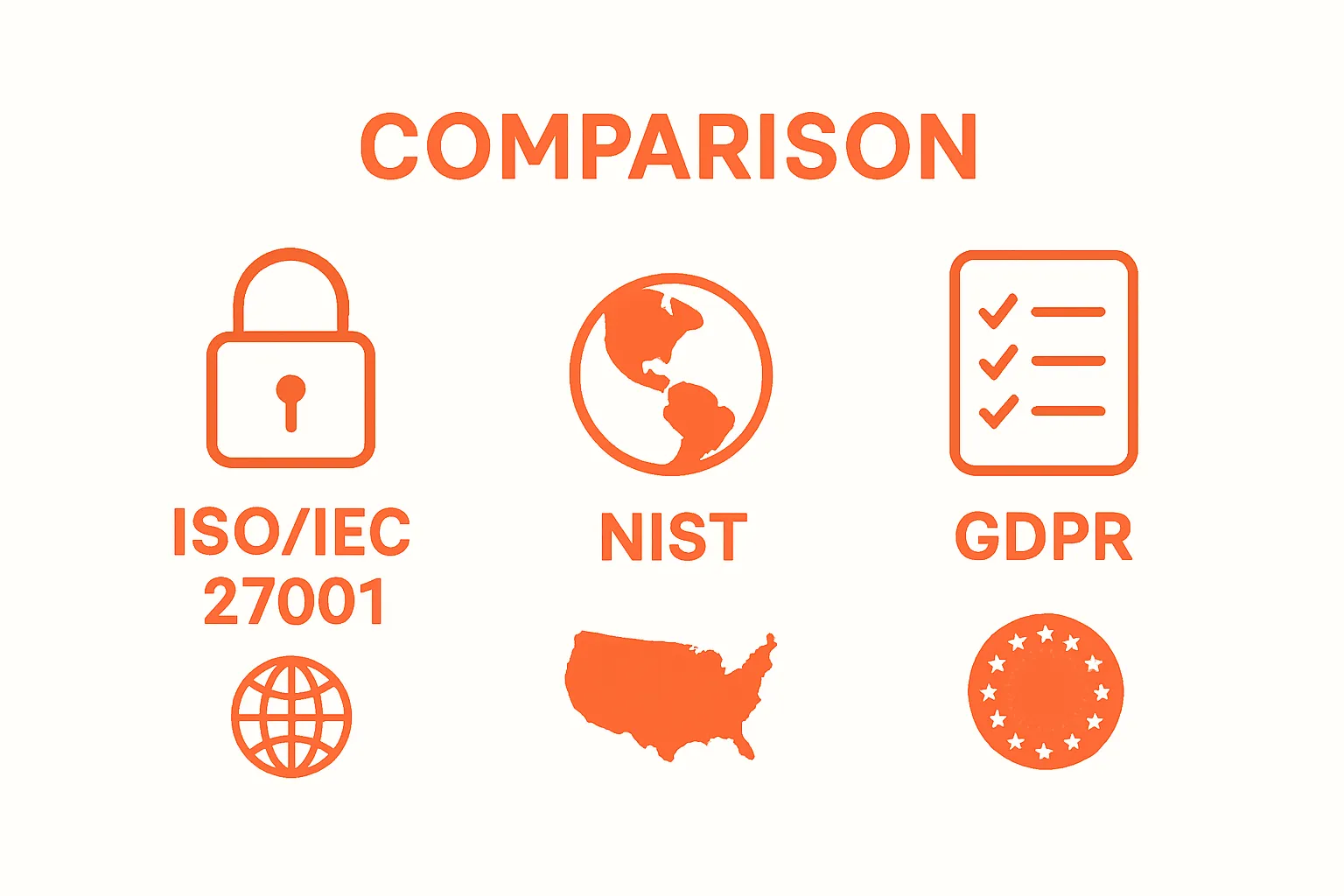
Understanding IT Compliance Requirements for Businesses
Staying on top of IT compliance is more than ticking off boxes for rules and regulations. Companies think a strong firewall is enough, but the numbers say otherwise. The average cost of a data breach hit $4.35 million in 2022, proving that unchecked compliance gaps can devastate even well-defended businesses. So what really protects your information is not just security, but a living system of policies, audits, and controls that change as threats evolve.
Table of Contents
- Defining It Compliance Requirements: What You Need To Know
- The Importance Of It Compliance: Protecting Your Business
- Key It Compliance Frameworks: Navigating Standards And Regulations
- How It Compliance Works: Integrating Into Business Practices
- Real-World Applications Of It Compliance In Various Industries
Quick Summary
| Takeaway | Explanation |
|---|---|
| Prioritize IT compliance continually. | IT compliance is an ongoing process that requires regular assessment and adaptation to changing regulations and security threats. |
| Focus on robust data protection measures. | Safeguarding sensitive information with strong security protocols is essential to maintain confidentiality and trust. |
| Implement regular risk assessments. | Continuous evaluation of technological vulnerabilities helps in proactive risk management and minimizes potential threats. |
| Understand sector-specific compliance frameworks. | Each industry has unique regulations, necessitating tailored compliance strategies for effective management of digital information. |
| Integrate compliance into business operations. | Compliance should be a strategic part of your organization, aligning with overall business objectives and fostering a culture of accountability. |
Defining IT Compliance Requirements: What You Need to Know
IT compliance requirements are systematic guidelines and regulations that businesses must follow to protect digital assets, maintain data security, and meet legal standards. These requirements encompass a comprehensive framework of technical, procedural, and administrative controls designed to safeguard organizational information systems.
The table below breaks down the key components of IT compliance mentioned in the article, providing concise definitions for each to support a clearer understanding of their roles.
| Component | Definition |
|---|---|
| Data Protection | Ensuring sensitive information remains confidential and secure |
| Risk Management | Identifying and mitigating potential technological vulnerabilities |
| Access Control | Regulating who can access specific systems and data |
| Audit Trail Maintenance | Documenting and tracking system activities and user interactions |
The Core Components of IT Compliance
At its foundation, IT compliance involves establishing a structured approach to managing technology resources while adhering to industry-specific regulations and legal mandates. Explore our comprehensive guide on IT policies for deeper insights into implementing robust compliance strategies.
Key components of IT compliance include:
- Data Protection: Ensuring sensitive information remains confidential and secure
- Risk Management: Identifying and mitigating potential technological vulnerabilities
- Access Control: Regulating who can access specific systems and data
- Audit Trail Maintenance: Documenting and tracking system activities and user interactions
According to NIST Special Publication 800-53, effective IT compliance requires a multifaceted approach that addresses security controls, organizational risk tolerance, and operational requirements.
Understanding Compliance Frameworks
Different industries have unique compliance frameworks tailored to their specific technological and regulatory environments. Financial services, healthcare, and technology sectors each have distinct requirements that dictate how organizations manage digital information.
Businesses must recognize that IT compliance is not a one-time achievement but an ongoing process of assessment, implementation, and continuous improvement. This dynamic approach ensures that technological infrastructure remains resilient against emerging cybersecurity threats and evolving regulatory landscapes.
The Importance of IT Compliance: Protecting Your Business
IT compliance is not merely a regulatory checkbox but a critical strategic defense mechanism that protects businesses from potentially catastrophic technological risks and legal vulnerabilities. Learn more about common IT challenges for SMEs to understand how proactive compliance can mitigate significant operational risks.
Financial and Reputational Consequences
Non-compliance can result in devastating financial penalties and irreparable reputational damage. According to IBM’s Cost of a Data Breach Report, the average total cost of a data breach in 2022 was $4.35 million, highlighting the substantial economic risks associated with inadequate IT security practices.
The table below presents the distinct consequences of non-compliance outlined in the article, showing how each can impact a business in tangible ways.
| Consequence | Description |
|---|---|
| Direct Monetary Penalties | Regulatory fines and legal settlements |
| Operational Disruption | Potential business shutdown or significant operational constraints |
| Lost Customer Trust | Long-term reputation damage and potential client exodus |
Key financial implications include:
- Direct Monetary Penalties: Regulatory fines and legal settlements
- Operational Disruption: Potential business shutdown or significant operational constraints
- Lost Customer Trust: Long-term reputation damage and potential client exodus
Strategic Risk Management
IT compliance transforms risk management from a reactive to a proactive strategy. By implementing robust compliance frameworks, organizations can systematically identify, assess, and mitigate potential technological vulnerabilities before they escalate into critical security breaches.
Companies that prioritize comprehensive IT compliance create a resilient technological ecosystem that not only protects against external threats but also builds stakeholder confidence. This approach demonstrates a commitment to data integrity, operational transparency, and responsible technological stewardship.
Key IT Compliance Frameworks: Navigating Standards and Regulations
IT compliance frameworks provide structured guidelines that help organizations establish systematic approaches to managing technological risks and regulatory requirements. Explore our insights on industry standards to understand the evolving landscape of technology governance.
Global Information Security Standards
International frameworks offer comprehensive blueprints for robust technological governance. ISO/IEC 27001 stands as a premier global standard for information security management, establishing critical protocols for protecting digital assets across diverse organizational environments.
Key global compliance frameworks include:
The following table organises some of the major global IT compliance frameworks referenced in the article, highlighting each standard and its primary area of focus for easier comparison.
| Framework | Primary Focus |
|---|---|
| ISO/IEC 27001 | International standard for information security |
| NIST Cybersecurity Framework | United States government’s security guidelines |
| GDPR | European Union data protection and privacy |
| PCI DSS | Payment Card Industry Data Security Standard |
| HIPAA | US healthcare patient data protection |

- ISO/IEC 27001: International standard for information security management
- NIST Cybersecurity Framework: United States government’s comprehensive security guidelines
- GDPR: European Union’s data protection and privacy regulation
- PCI DSS: Payment Card Industry Data Security Standard
Industry-Specific Compliance Requirements
Different sectors demand specialized compliance approaches tailored to their unique technological and regulatory landscapes. Financial institutions, healthcare providers, and technology companies each face distinct regulatory environments that require nuanced compliance strategies.
For example, healthcare organizations must adhere to HIPAA regulations, which mandate strict protocols for protecting patient data and ensuring confidential information remains secure. Similarly, financial services must comply with regulations that protect sensitive financial information and prevent potential fraud.
Successful navigation of these complex frameworks requires a proactive approach that views compliance not as a bureaucratic obligation, but as a strategic opportunity to enhance organizational resilience, build stakeholder trust, and demonstrate technological sophistication.
How IT Compliance Works: Integrating into Business Practices
IT compliance is not a standalone function but a comprehensive organizational strategy that requires systematic integration across all technological and operational domains. Explore our comprehensive guide on compliance strategies to understand the intricate mechanisms of effective implementation.
Developing a Compliance Framework
Successful IT compliance integration demands a holistic approach that aligns technological infrastructure with regulatory requirements and organizational objectives. According to International Association of Privacy Professionals, embedding compliance requires cross-functional collaboration and strategic alignment.
Essential components of an effective compliance framework include:
- Risk Assessment: Continuous identification and evaluation of potential technological vulnerabilities
- Policy Development: Creating clear, comprehensive guidelines that address specific regulatory requirements
- Technology Implementation: Deploying technical controls and monitoring systems
- Training and Awareness: Ensuring all staff understand compliance obligations
Continuous Monitoring and Adaptation
Compliance is not a static achievement but a dynamic process of ongoing assessment, refinement, and adaptation. Organizations must establish robust mechanisms for continuous monitoring, regular audits, and proactive risk management.
This approach requires implementing sophisticated technological tools that enable real-time tracking of compliance metrics, automated reporting, and immediate detection of potential regulatory deviations.
 By treating compliance as an evolving strategic initiative, businesses can transform regulatory requirements from potential obstacles into opportunities for enhanced operational excellence and technological resilience.
By treating compliance as an evolving strategic initiative, businesses can transform regulatory requirements from potential obstacles into opportunities for enhanced operational excellence and technological resilience.
Real-World Applications of IT Compliance in Various Industries
IT compliance transcends theoretical frameworks, manifesting as a critical operational necessity across diverse industry sectors. Learn about advanced access control strategies to understand how technological safeguards vary across different business environments.
Financial Services Compliance
Financial institutions operate within the most rigorous regulatory landscapes, where compliance is not optional but fundamental to maintaining operational legitimacy. According to Deloitte’s Global Financial Services Compliance Report, financial organizations must implement comprehensive technological controls to protect sensitive financial data and prevent potential fraud.
Key compliance requirements in financial services include:
- Transaction Monitoring: Tracking and recording all financial transactions
- Customer Verification: Implementing robust identity authentication protocols
- Data Encryption: Protecting sensitive financial information
- Regular Audit Trails: Maintaining comprehensive documentation of all financial activities
Healthcare and Medical Technology Compliance
Healthcare organizations manage some of the most sensitive personal information, necessitating extraordinarily strict compliance protocols. HIPAA regulations mandate comprehensive technological and procedural safeguards to protect patient data, requiring healthcare providers to implement sophisticated information management systems.
Companies in this sector must develop multilayered compliance strategies that integrate technological solutions with stringent privacy protection mechanisms. This approach ensures patient confidentiality while maintaining the operational efficiency required in modern medical environments, transforming regulatory requirements from potential barriers into opportunities for enhanced patient care and trust.
Ready to Simplify Your IT Compliance Journey?
Struggling to keep up with evolving IT compliance requirements can drain your resources and leave your business exposed. If you are concerned about data protection, risk management or staying on top of local and international standards, you are not alone. Many professional firms, especially those in engineering and finance, face the ongoing challenge of maintaining robust IT frameworks to avoid costly breaches and regulatory penalties. Your business deserves more than a reactive approach. With proactive security and reliable support, you can transform compliance from a burden into a strategic advantage.
Do not let complex rules disrupt your operations or your reputation. Explore how Techtron’s managed IT services lessen your compliance stress while safeguarding your data and systems. Take the next step towards peace of mind and operational continuity by visiting our landing page. If you want to see more about our expertise in IT policies, discover how we deliver tailored solutions for businesses like yours. Let us help you protect your digital assets and build lasting trust with your clients. Act today to empower your organisation with seamless IT management.
Frequently Asked Questions
What are IT compliance requirements?
IT compliance requirements are systematic guidelines and regulations that businesses must follow to protect their digital assets, maintain data security, and meet legal standards. They encompass a framework of technical, procedural, and administrative controls designed to safeguard organizational information systems.
Why is IT compliance important for businesses?
IT compliance is crucial as it protects businesses from financial penalties and reputational damage associated with non-compliance. It also transforms risk management into a proactive strategy, ensuring businesses are resilient against cybersecurity threats and legal vulnerabilities.
What are the key components of IT compliance?
The key components of IT compliance include data protection, risk management, access control, and audit trail maintenance. These components work together to establish a structured approach to managing technology resources while adhering to industry-specific regulations.
How do organizations implement IT compliance frameworks?
Organizations implement IT compliance frameworks by developing risk assessments, creating comprehensive policies, deploying technology controls, and ensuring continuous training and awareness among staff. This holistic approach requires cross-functional collaboration to align regulatory requirements with business objectives.